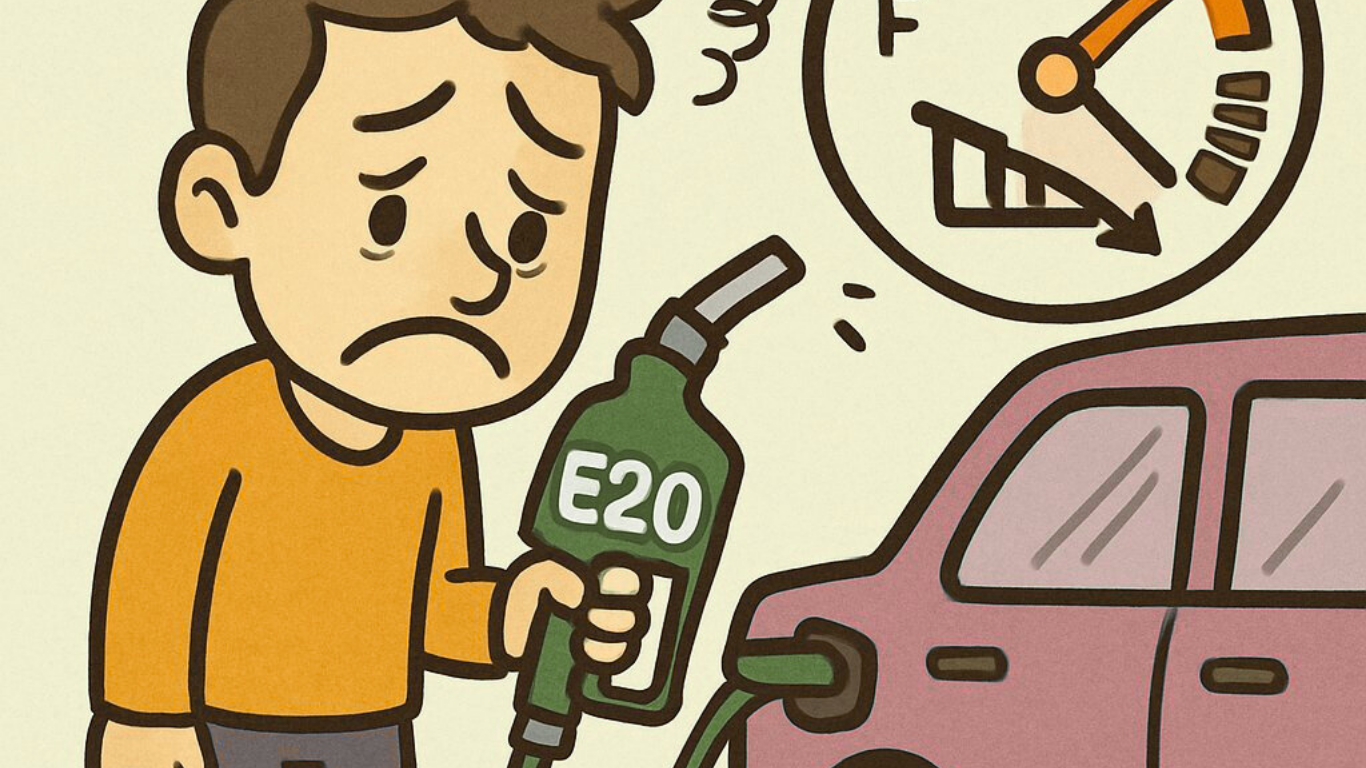
New Delhi, India, August 4, 2025 — India’s push for cleaner fuel has brought E20 petrol—a blend of 20% ethanol and 80% regular petrol—to pumps across the country. Launched as part of the government’s Ethanol Blended Petrol (EBP) program, E20 aims to cut pollution, reduce oil imports, and support farmers by using sugarcane-based ethanol. While the environmental and economic goals are commendable, many drivers and carmakers are raising alarms about the risks E20 poses to vehicles, especially older models not built for it. From engine damage to reduced mileage, here’s a thorough review into how E20 petrol could harm your car and what you can do to protect it.
What Is E20 Petrol?
E20 petrol is a fuel mix containing 20% ethanol, a biofuel made from fermenting sugarcane, corn, or other organic materials, and 80% traditional petrol. India began its EBP journey with E5 (5% ethanol) and moved to E10 (10% ethanol) in recent years. In 2023, Prime Minister Narendra Modi accelerated the rollout of E20 during the India Energy Week in Bengaluru, aiming for nationwide adoption by 2025. The goal? Slash carbon emissions, save billions on oil imports (India spent $551 billion on 185 million tonnes of petroleum in 2020-21), and boost local agriculture. Ethanol burns cleaner, reducing carbon monoxide by up to 50% in two-wheelers and 30% in cars, and hydrocarbons by 20%, according to studies by the Automotive Research Association of India (ARAI).
But cleaner doesn’t always mean better for your car. Ethanol’s properties—lower energy content, water-absorbing nature, and corrosiveness—can spell trouble for vehicles not designed to handle it. With E20 becoming more common at pumps, drivers are noticing issues, and experts are warning of long-term damage.
The Hidden Risks of E20 Petrol
1. Engine and Fuel System Damage
Ethanol is hygroscopic, meaning it absorbs water from the air. This can lead to corrosion in metal parts like fuel tanks, lines, valves, and injectors, especially in older vehicles built before 2023, which are typically calibrated for E10 or lower. Rubber seals, gaskets, and plastic components in fuel systems can also degrade faster with E20, causing leaks, clogs, or even fire hazards. A 2022 Maruti Suzuki Brezza owner in Chennai, Akanksha Bokdia, told South First, “Mileage dropped sharply to around 14 km/L from 17-18 km/L, and the pickup feels sluggish.” Such complaints are common among owners of non-E20-compliant vehicles.
Carmakers like Hero Motorcorp and TVS have noted that older vehicles may need costly upgrades—replacing rubber hoses, O-rings, and fuel tubes with ethanol-resistant materials—to safely use E20. Without these changes, prolonged use can lead to fuel system failures. A report by South First quoted experts warning that forcing E20 into unprepared vehicles could cause “widespread reliability issues and road safety hazards.”
2. Reduced Mileage and Performance
Ethanol has about 33% less energy than petrol, so E20 delivers 6-7% lower mileage on average, according to ARAI and Indian Oil Corporation studies from 2015. This means more trips to the pump and higher fuel costs over time. Drivers like Subramaniam from Thiruvananthapuram reported a 2-3 km/L drop in mileage and sluggish acceleration, especially in older petrol sedans. Engine knocking, rough idling, and cold-start issues are also common, as ethanol burns differently than petrol, stressing engines not tuned for it.
Newer vehicles, like some Toyota and Honda models built after 2013, are designed with E20-compatible materials and tuned engines, minimizing these issues. A joint study by MIT and Honda R&D found that E20-optimized engines can achieve up to 20% better efficiency and a 5% CO2 reduction compared to regular petrol. But for older BS4 or BS6 Phase 1 vehicles, the performance hit is noticeable, and manufacturers warn that damage from E20 use may void warranties.
3. Warranty and Repair Concerns
Most automakers, including Kia and Jeep, have stated that vehicles calibrated for E10 may suffer damage from E20 that isn’t covered under warranty. This leaves owners of pre-2023 models at risk of footing hefty repair bills for corroded fuel lines or clogged injectors. The lack of clear fuel labeling at pumps adds to the problem—many drivers unknowingly fill up with E20, only to face issues later. “It’s like playing Russian roulette with your car,” said a Team-BHP user, highlighting the frustration over vague pump markings.
4. Environmental Trade-Offs
While E20 reduces carbon monoxide and hydrocarbon emissions, it’s not a perfect win for the environment. The lower mileage means more fuel is burned to cover the same distance, offsetting some emission benefits. Ethanol production also raises concerns about soil erosion, pesticide use, and deforestation from intensive farming. Acetaldehyde emissions, though minor, are higher with E20 than with regular petrol, adding to air pollution in some cases. Sustainable farming practices are critical to minimizing these downsides, but scaling up ethanol production remains a challenge.
Who’s Affected Most?
Older vehicles—those manufactured before April 2023—are at the highest risk. BS4 and BS6 Phase 1 cars and two-wheelers, designed for E5 or E10, lack the anti-corrosive materials and engine tuning needed for E20. Owners of vintage or classic cars face even bigger headaches, as ethanol can wreak havoc on aging fuel systems. A Team-BHP user noted, “Anything over 25-30 years is likely to have serious problems even with E10, let alone E20.”
Newer models, especially from brands like Toyota (post-2013) and Honda (post-2009), are better equipped, with ethanol-resistant components and remapped ECUs. Check your car’s manual to confirm E20 compatibility—most manufacturers specify the maximum ethanol blend allowed. If your vehicle is E10-only, sticking to E10 or premium fuels with lower ethanol content (like Shell or BP’s 98-octane options) is safer, though not always available.
What Can Drivers Do?
1. Check Compatibility: Look in your car’s manual or contact the manufacturer to confirm if your vehicle can handle E20. Websites from automakers often list E20-compatible models by year and make.
2. Use Additives: Fuel additives designed to combat ethanol-related issues, like corrosion inhibitors, can help protect older vehicles, though they’re not foolproof.
3. Monitor Performance: Watch for signs like reduced mileage, engine knocking, or rough idling. If you notice these, consult a mechanic and consider switching to E10 if available.
4. Demand Clear Labeling: The lack of pump labeling is a major issue. Advocate for better regulation to ensure drivers know what fuel they’re using.
5. Consider Upgrades: For older vehicles, replacing rubber hoses and seals with ethanol-resistant parts can reduce risks, though this can be expensive.
The Bigger Picture
The push for E20 is driven by solid goals: reducing India’s $551 billion oil import bill, cutting emissions, and supporting farmers. In 2023-24, ethanol blending saved ₹2 lakh crore, and the program has created jobs in the biofuel and agriculture sectors. But the rushed rollout—moved from 2030 to 2025—has left carmakers and drivers scrambling. Manufacturers argue for a phased approach to give owners time to adapt, while experts call for better public awareness campaigns.
Posts on X reflect growing concern among drivers, with many sharing stories of reduced mileage and engine issues after using E20. Some praise the environmental benefits but urge the government to clarify which vehicles are safe. The debate is heating up, with calls for transparency and support for owners of older cars.
Updates as of Now:
The Ministry of Petroleum and Natural Gas announced plans to expand E20 pumps to 50 more cities by October, but no updates on improved fuel labeling. Maruti Suzuki issued a statement urging owners of pre-2023 models to check E20 compatibility before refueling, citing potential warranty issues.
The Road Ahead
E20 petrol is a step toward a greener India, but it’s not a one-size-fits-all solution. While newer vehicles may thrive, older cars face real risks of damage, higher costs, and voided warranties. Drivers must stay informed, check compatibility, and push for clearer policies to navigate this fuel transition safely. Until then, E20 could be a slow poison for your car if you’re not prepared.



